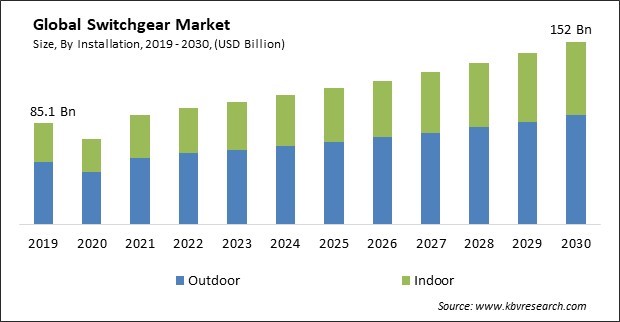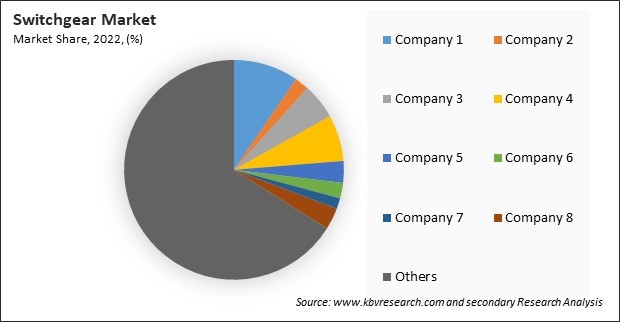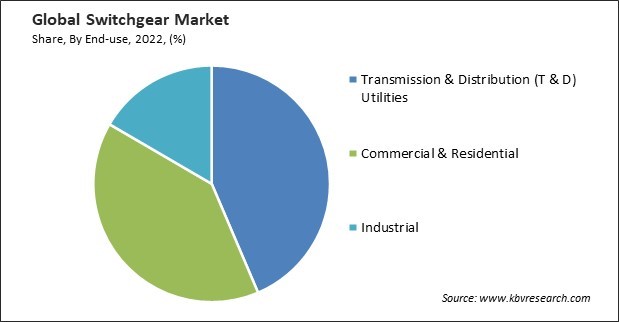The Global Switchgear Market size is expected to reach $152 billion by 2030, rising at a market growth of 5.8% CAGR during the forecast period. In the year 2022, the market attained a volume of 33704 thousand units, experiencing a growth of 5.9% (2019-2022).
The demand for switchgear solutions that are efficient and dependable is increasing as a result of the region's rapid development and urbanization. Thus, the Asia Pacific region registered $34,179.8 million revenue in the market in 2022. The increasing emphasis on renewable energy sources and the incorporation of smart grid technologies led to the adoption of sophisticated switchgear systems that manage complex power distribution networks. The growth of sectors, including oil and gas, manufacturing, and construction, further boosts demand for switchgear products in the Asia Pacific region, as are expenditures in infrastructure development projects. As end-users prioritize installing dependable switchgear systems to safeguard their operations and maintain uninterrupted power flow, the need for uninterrupted power supply and the growing relevance of electrical safety generates opportunities for market expansion. Some of the factors affecting the market are rising demand for electricity, integration of digital technologies and IOT, and regulations restricting SF6 gas emissions.

The increasing global demand for electricity, driven by population growth, urbanization, and industrialization, is a significant driver for the market. It plays a crucial role in the transmission and distribution of electrical power. As the electricity demand grows, there is a need to expand power generation capacity. This often involves the construction of new power plants, whether fossil fuel-based, renewable, or nuclear. Moreover, integrating digital technologies and the Internet of Things (IoT) into switchgear systems allows for remote monitoring, predictive maintenance, and enhanced performance optimization, driving the adoption of modern switchgear solutions. Digital switchgear systems with IoT sensors and communication capabilities allow real-time remote monitoring and control. Digitalization and IoT integration are pivotal in achieving these goals, and meeting the increasing demands of modern power distribution is a crucial driver for market expansion.
However, Governments and regulatory authorities in various regions have set ambitious emission reduction targets, including specific goals for reducing SF6 emissions. These targets often align with broader climate action and sustainability objectives. Regulations typically establish timelines for the phase-out or reduction of SF6 gas in switchgear and related equipment. These timelines vary by region but aim to significantly reduce SF6 emissions over time. The increased impact of F-gas regulations on SF6 will impact the market’s growth negatively.

The leading players in the market are competing with diverse innovative offerings to remain competitive in the market. The above illustration shows the percentage of revenue shared by some of the leading companies in the market. The leading players of the market are adopting various strategies in order to cater demand coming from the different industries. The key developmental strategies in the market are Acquisitions, and Partnerships & Collaborations.
By voltage type, the market is categorized into low voltage, medium voltage, and high voltage. The high voltage segment covered a considerable revenue share in the market in 2022. In medium-voltage-type networks, medium-voltage ensures effective and safe power distribution, protection, and control. Additionally, upgrading aging electrical infrastructure offers a vast market opportunity, particularly in emerging economies. The demand for novel medium-voltage products and solutions is also being fueled by the growing emphasis on grid resilience, smart grid technologies, and the integration of cutting-edge digital solutions.
By end-use, the market is segmented into transmission & distribution (T&D) utilities, commercial & residential, and industrial. In 2022, the transmission & distribution (T&D) utilities segment registered the maximum revenue share in the market. Rapid urbanization and industrialization in the segment are significant factors fueling the demand for switchgear, as they require efficient electrical distribution and protection systems. Furthermore, the proliferation of data centres, the adoption of smart grids, and the increasing focus on renewable energy sources all contribute to the market.

On the basis of installation, the market is divided into indoor and outdoor. The indoor segment garnered a significant revenue share in the market in 2022. Demand for indoor installations has increased due to the increased focus on safety and dependability in electrical systems, as they provide better protection against outside factors and unwanted access. The expanding use of smart grid technologies and the incorporating of renewable energy sources has increased the need for advanced indoor solutions capable of managing power distribution efficiently and accommodating complex grid configurations. In addition, the ongoing urbanization and infrastructure expansion in developing economies have improved the demand for indoor switchgear installations, which offer space-saving benefits and can be readily integrated into dense urban environments.
Based on insulation, the market is classified into vacuum, air, gas, and oil. In 2022, the vaccum segment witnessed the largest revenue share in the market. Vacuum switchgear is known for its high reliability and safety features. It provides excellent arc quenching capabilities, reducing the risk of electrical faults and fires. This high level of reliability makes it suitable for critical applications, such as power distribution in industries and infrastructure. Vacuum switchgear is compact and space-efficient, which is particularly valuable in urban areas with limited space for electrical infrastructure. Its smaller footprint allows for easier installation and retrofitting in existing substations. The vacuum segment in the market has experienced significant growth due to several advantages it offers over other interrupting mediums, such as oil and sulfur hexafluoride (SF6).
| Report Attribute | Details |
|---|---|
| Market size value in 2022 | USD 97.4 Billion |
| Market size forecast in 2030 | USD 152 Billion |
| Base Year | 2022 |
| Historical Period | 2019 to 2021 |
| Forecast Period | 2023 to 2030 |
| Revenue Growth Rate | CAGR of 5.8% from 2023 to 2030 |
| Number of Pages | 426 |
| Number of Table | 850 |
| Quantitative Data | Volume in Thousand Units, Revenue in USD Million, and CAGR from 2019 to 2030 |
| Report coverage | Market Trends, Revenue Estimation and Forecast, Segmentation Analysis, Regional and Country Breakdown, Market Share Analysis, Companies Strategic Developments, Company Profiling |
| Segments covered | Type, Application, End Use, Region |
| Country scope | US, Canada, Mexico, Germany, UK, France, Russia, Spain, Italy, China, Japan, India, South Korea, Singapore, Malaysia, Brazil, Argentina, UAE, Saudi Arabia, South Africa, Nigeria |
| Growth Drivers |
|
| Restraints |
|
Region-wise, the market is analysed across North America, Europe, Asia Pacific, and LAMEA. In 2022, the North America region acquired a significant revenue share in the market. Population growth, industrialization, and urbanization have amplified the region's need for efficient power distribution and transmission systems, driving electricity demand. In addition, North America's aging infrastructure and increasing emphasis on grid modernization and renewable energy integration are driving demand for advanced switchgear solutions. Additionally, there are prospects for integrating intelligent switchgear systems that improve energy management and maximize operational efficiency due to the development of smart grids and the rapid adoption of digital technologies like IoT and cloud computing.
Free Valuable Insights: Global Switchgear Market size to reach USD 152 Billion by 2030
The market research report covers the analysis of key stakeholders of the market. Key companies profiled in the report include ABB Ltd., Alstom SA, Bharat Heavy Electricals Ltd., Eaton Corporation PLC, General Electric Company, Legrand Group, Hitachi, Ltd., Crompton Greaves Consumer Electricals Limited., Larsen & Toubro Limited, Mitsubishi Electric Corporation.
By Installation (Volume, Thousand Units, USD Million, 2019-2030)
By Insulation (Volume, Thousand Units, USD Million, 2019-2030)
By Voltage Type (Volume, Thousand Units, USD Million, 2019-2030)
By End use (Volume, Thousand Units, USD Million, 2019-2030)
By Geography (Volume, Thousand Units, USD Million, 2019-2030)
This Market size is expected to reach $152 billion by 2030.
Rising demand for electricity are driving the Market in coming years, however, Regulations Restricting SF6 gas emissions restraints the growth of the Market.
ABB Ltd., Alstom SA, Bharat Heavy Electricals Ltd., Eaton Corporation PLC, General Electric Company, Legrand Group, Hitachi, Ltd., Crompton Greaves Consumer Electricals Limited., Larsen & Toubro Limited, Mitsubishi Electric Corporation.
In the year 2022, the market attained a volume of 33704 thousand units, experiencing a growth of 5.9% (2019-2022).
The Outdoor segment is leading the Market by Installation in 2022; thereby, achieving a market value of $91.1 billion by 2030.
The Asia Pacific market dominated the Market by Region in 2022 and would continue to be a dominant market till 2030; thereby, achieving a market value of $55.1 billion by 2030.
Our team of dedicated experts can provide you with attractive expansion opportunities for your business.

